Performance Evaluation of ERA5 Extreme Precipitation in the Yangtze River Delta, China
Abstract
:1. Introduction
2. Materials and Methods
2.1. Study Area
2.2. Datasets
- (1)
- The surface observational sub-daily precipitation dataset was derived from the National Meteorological Information Center of the China Meteorological Administration, spanning 1961–2018. The dataset provides accumulated precipitation records every 12 h, i.e., 8:00 and 20:00 Beijing Time (BT). Daytime denotes 8:00 to 20:00 BT, whereas nighttime denotes 20:00 of the last day to 8:00 of the current day. This dataset was released after strict quality control and homogeneity tests and is available from http://data.cma.cn/ (accessed on 19 July 2022). Considering the reliability and integrity of the data, the stations with ≥3% of all daily or sub-daily values missing during the study period were removed. Missing values for stations (<3% missing data) were replaced by values of adjacent stations [51]. Ultimately, 185 surface observational stations were used to evaluate the reanalysis data (Figure 1).
- (2)
- The ERA5, with a 0.25° spatial resolution and a 1-h temporal resolution, is the fifth-generation reanalysis dataset of the European Centre for Medium-Range Weather Forecasts, which includes detailed hydrometeorological reanalysis data for two time periods (1950–1978 and 1978–present) [37]. The ERA5 has relatively smaller errors than the previous version ERA-Interim when compared to observations [41]. This reanalysis product has been widely used in hydrometeorological studies [26,52,53]. It is available from https://www.ecmwf.int/en/forecasts/datasets/reanalysis-datasets/era5 (accessed on 19 July 2022).
2.3. Statistical Analysis
2.3.1. Evaluation Metrics
2.3.2. Trend Calculation
2.4. Definition of Extreme Precipitation
3. Results
3.1. Overall Evaluation of ERA5 Precipitation Data
3.2. Climatological Patterns in Annual Total Extreme Precipitation
3.3. Seasonal Cycles of Daily/Sub-Daily Extreme Precipitation
3.4. Interannual Variations of Daily/Sub-Daily Extreme Precipitation
3.5. Spatial Patterns of Extreme Precipitation Evaluation
3.6. Patterns of Convective/Large-Scale Precipitation during Extreme Precipitation
4. Discussion
5. Conclusions
- (1)
- The threshold obtained from the 90th-percentile extraction using the daily ERA5 precipitation amount of >1 mm was very close to the threshold based on observations. Both the ERA5 total precipitation and extreme precipitation data at the all-day and all-month scales exhibited relatively good performance and reproducibility.
- (2)
- A spatial comparison showed that ERA5 effectively reproduced the spatial distribution of climatological extreme precipitation frequency and amount in the YRD region. It also showed higher correlations of the extreme precipitation amount between the ERA5 and surface observations at the monthly scale. ERA5 successfully represented the seasonal cycle and interannual variability of daily, daytime, and nighttime extreme precipitation. Daytime (nighttime) ERA5 extreme precipitation frequency and amount tended to be overestimated (underestimated) for the period 1961–2000, whereas they were significantly underestimated for the period 2000–2018. The estimation of annual and seasonal trends in ERA5 extreme precipitation remains to be improved.
- (3)
- ERA5 revealed that the annual mean convective/large-scale precipitation that contributes to extreme precipitation in the YRD was more in the south and less in the north. Extreme precipitation in the YRD was dominated by large-scale precipitation, with convective precipitation as an important supplement; however, their multiyear trends were not clear.
Supplementary Materials
Author Contributions
Funding
Institutional Review Board Statement
Informed Consent Statement
Data Availability Statement
Acknowledgments
Conflicts of Interest
References
- IPCC. Summary for Policymakers. Climate Change 2021: The Physical Science Basis. In Contribution of Working Group I to the Sixth Assessment Report of the Intergovernmental Panel on Climate Change; Masson-Delmotte, V.P., Zhai, A., Pirani, S.L., Connors, C., Péan, S., Berger, N., Caud, Y., Chen, L., Goldfarb, M.I., Gomis, M., et al., Eds.; Cambridge University Press: Cambridge, UK, 2021. [Google Scholar]
- Allan, R.P.; Barlow, M.; Byrne, M.P.; Cherchi, A.; Douville, H.; Fowler, H.J.; Gan, T.Y.; Pendergrass, A.G.; Rosenfeld, D.; Swann, A.L.S.; et al. Advances in understanding large-scale responses of the water cycle to climate change. Ann. N. Y. Acad. Sci. 2020, 1472, 49–75. [Google Scholar] [CrossRef]
- Allan, R.P.; Soden, B.J. Atmospheric warming and the amplification of precipitation extremes. Science 2008, 321, 1481–1484. [Google Scholar] [CrossRef] [PubMed]
- Zhang, W.; Furtado, K.; Wu, P.; Zhou, T.; Chadwick, R.; Marzin, C.; Rostron, J.; Sexton, D. Increasing precipitation variability on daily-to-multiyear time scales in a warmer world. Sci. Adv. 2021, 7, eabf8021. [Google Scholar] [CrossRef] [PubMed]
- Zhai, P.; Zhang, X.; Wan, H.; Pan, X. Trends in Total Precipitation and Frequency of Daily Precipitation Extremes over China. J. Clim. 2005, 18, 1096–1108. [Google Scholar] [CrossRef]
- Pendergrass, A.G. What precipitation is extreme? Science 2018, 360, 1072. [Google Scholar] [CrossRef]
- Gualdi, S.; Scoccimarro, E.; Bellucci, A.; Zampieri, M.; Navarra, A. Heavy Precipitation Events in a Warmer Climate: Results from CMIP5 Models. J. Clim. 2013, 26, 7902–7911. [Google Scholar]
- Zhou, Z.Q.; Xie, S.P.; Zhang, R. Historic Yangtze flooding of 2020 tied to extreme Indian Ocean conditions. Proc. Natl. Acad. Sci. USA 2021, 118, e2022255118. [Google Scholar] [CrossRef]
- Cho, C.; Li, R.; Wang, S.Y.; Yoon, J.-H.; Gillies, R.R. Anthropogenic footprint of climate change in the June 2013 northern India flood. Clim. Dyn. 2015, 46, 797–805. [Google Scholar] [CrossRef]
- Zeppel, M.J.B.; Wilks, J.V.; Lewis, J.D. Impacts of extreme precipitation and seasonal changes in precipitation on plants. Biogeoscience 2014, 11, 3083–3093. [Google Scholar] [CrossRef]
- Nie, Y.; Sun, J. Moisture Sources and Transport for Extreme Precipitation Over Henan in July 2021. Geophys. Res. Lett. 2022, 49, e2021GL097446. [Google Scholar] [CrossRef]
- Schaller, N.; Kay, A.L.; Lamb, R.; Massey, N.R.; van Oldenborgh, G.J.; Otto, F.E.L.; Sparrow, S.N.; Vautard, R.; Yiou, P.; Ashpole, I.; et al. Human influence on climate in the 2014 southern England winter floods and their impacts. Nat. Clim. Chang. 2016, 6, 627–634. [Google Scholar] [CrossRef]
- IPCC. Managing the risks of extreme events and disasters to advance climate change adaptation. In A Special Report of Working Groups I and II of the Intergovernmental Panel on Climate Change; Cambridge University Press: Cambridge, UK, 2012. [Google Scholar]
- Myhre, G.; Alterskjaer, K.; Stjern, C.W.; Hodnebrog, O.; Marelle, L.; Samset, B.H.; Sillmann, J.; Schaller, N.; Fischer, E.; Schulz, M.; et al. Frequency of extreme precipitation increases extensively with event rareness under global warming. Sci. Rep. 2019, 9, 16063. [Google Scholar] [CrossRef] [PubMed]
- Zhang, W.; Zhou, T.; Zou, L.; Zhang, L.; Chen, X. Reduced exposure to extreme precipitation from 0.5 degrees C less warming in global land monsoon regions. Nat. Commun. 2018, 9, 3153. [Google Scholar] [CrossRef] [PubMed]
- Chinita, M.J.; Richardson, M.; Teixeira, J.; Miranda, P.M.A. Global mean frequency increases of daily and sub-daily heavy precipitation in ERA5. Environ. Res. Lett. 2021, 16, 074035. [Google Scholar] [CrossRef]
- You, S.; Chen, X. Regional integration degree and its effect on a city’s green growth in the Yangtze River Delta: Research based on a single-city regional integration index. Clean Technol. Environ. Policy 2021, 23, 1837–1849. [Google Scholar] [CrossRef]
- Shen, L.; Wen, J.; Zhang, Y.; Ullah, S.; Cheng, J.; Meng, X. Changes in population exposure to extreme precipitation in the Yangtze River Delta, China. Clim. Serv. 2022, 27, 100317. [Google Scholar] [CrossRef]
- Hu, G.; Franzke, C.L.E. Evaluation of Daily Precipitation Extremes in Reanalysis and Gridded Observation-Based Data Sets Over Germany. Geophys. Res. Lett. 2020, 47, e2020GL089624. [Google Scholar] [CrossRef]
- Rivoire, P.; Martius, O.; Naveau, P. A Comparison of Moderate and Extreme ERA-5 Daily Precipitation With Two Observational Data Sets. Earth Space Sci. 2021, 8, e2020EA001633. [Google Scholar] [CrossRef]
- Liao, X.; Xu, W.; Zhang, J.; Li, Y.; Tian, Y. Global exposure to rainstorms and the contribution rates of climate change and population change. Sci. Total Environ. 2019, 663, 644–653. [Google Scholar] [CrossRef]
- Wang, Y.; Li, H.; Wang, H.; Sun, B.; Chen, H. Evaluation of CMIP6 model simulations of extreme precipitation in China and comparison with CMIP5. Acta Meteorol. Sin. 2021, 79, 369–386. [Google Scholar]
- Liu, Y.; Geng, X.; Hao, Z.; Zheng, J. Changes in Climate Extremes in Central Asia under 1.5 and 2 °C Global Warming and their Impacts on Agricultural Productions. Atmosphere 2020, 11, 1076. [Google Scholar] [CrossRef]
- Wu, Y.; Wu, S.-Y.; Wen, J.; Xu, M.; Tan, J. Changing characteristics of precipitation in China during 1960–2012. Int. J. Clim. 2016, 36, 1387–1402. [Google Scholar] [CrossRef] [Green Version]
- Li, Y.; Guo, B.; Wang, K.; Wu, G.; Shi, C. Performance of TRMM Product in Quantifying Frequency and Intensity of Precipitation during Daytime and Nighttime across China. Remote Sens. 2020, 12, rs12040740. [Google Scholar] [CrossRef]
- Jiang, Q.; Li, W.; Fan, Z.; He, X.; Sun, W.; Chen, S.; Wen, J.; Gao, J.; Wang, J. Evaluation of the ERA5 reanalysis precipitation dataset over Chinese Mainland. J. Hydrol. 2021, 595, 125660. [Google Scholar] [CrossRef]
- Chen, H.; Yu, R.; Li, J.; Yuan, W.; Zhou, T. Why Nocturnal Long-Duration Rainfall Presents an Eastward-Delayed Diurnal Phase of Rainfall down the Yangtze River Valley. J. Clim. 2010, 23, 905–917. [Google Scholar] [CrossRef]
- Adler, R.F.; Sapiano, M.R.P.; Huffman, G.J.; Wang, J.-J.; Gu, G.; Bolvin, D.; Chiu, L.; Schneider, U.; Becker, A.; Nelkin, E.; et al. The Global Precipitation Climatology Project (GPCP) Monthly Analysis (New Version 2.3) and a Review of 2017 Global Precipitation. Atmosphere 2018, 9, 138. [Google Scholar] [CrossRef]
- Kidd, C.; Levizzani, V. Status of satellite precipitation retrievals. Hydrol. Earth Syst. Sci. 2011, 15, 1109–1116. [Google Scholar] [CrossRef]
- Zhou, C.; Wang, K. Contrasting Daytime and Nighttime Precipitation Variability between Observations and Eight Reanalysis Products from 1979 to 2014 in China. J. Clim. 2017, 30, 6443–6464. [Google Scholar] [CrossRef]
- You, Q.; Bao, Y.; Jiang, Z.; Pepin, N.; Moore, G.W.K. Surface pressure and elevation correction from observation and multiple reanalyses over the Tibetan Plateau. Clim. Dyn. 2019, 53, 5893–5908. [Google Scholar] [CrossRef]
- Dee, D.P.; Uppala, S.M.; Simmons, A.J.; Berrisford, P.; Poli, P.; Kobayashi, S.; Andrae, U.; Balmaseda, M.A.; Balsamo, G.; Bauer, P.; et al. The ERA-Interim reanalysis: Configuration and performance of the data assimilation system. Quart. J. Royal Meteorol. Soc. 2011, 137, 553–597. [Google Scholar] [CrossRef]
- Kobayashi, S.; Ota, Y.; Harada, Y.; Ebita, A.; Moriya, M.; Onoda, H.; Onogi, K.; Kamahori, H.; Kobayashi, C.; Endo, H.; et al. The JRA-55 Reanalysis: General Specifications and Basic Characteristics. J. Meteorol. Soc. Japan Ser. II 2015, 93, 5–48. [Google Scholar] [CrossRef]
- Gelaro, R.; McCarty, W.; Suárez, M.J.; Todling, R.; Molod, A.; Takacs, L.; Randles, C.A.; Darmenov, A.; Bosilovich, M.G.; Reichle, R.; et al. The Modern-Era Retrospective Analysis for Research and Applications, Version 2 (MERRA-2). J. Clim. 2017, 30, 5419–5454. [Google Scholar] [CrossRef] [PubMed]
- Saha, S.; Moorthi, S.; Wu, X.; Wang, J.; Nadiga, S.; Tripp, P.; Behringer, D.; Hou, Y.-T.; Chuang, H.-y.; Iredell, M.; et al. The NCEP Climate Forecast System Version 2. J. Clim. 2014, 27, 2185–2208. [Google Scholar] [CrossRef]
- Harrigan, S.; Zsoter, E.; Alfieri, L.; Prudhomme, C.; Salamon, P.; Wetterhall, F.; Barnard, C.; Cloke, H.; Pappenberger, F. GloFAS-ERA5 operational global river discharge reanalysis 1979–present. Earth Syst. Sci. Data. 2020, 12, 2043–2060. [Google Scholar] [CrossRef]
- Hersbach, H.; Bell, B.; Berrisford, P.; Hirahara, S.; Horányi, A.; Muñoz-Sabater, J.; Nicolas, J.; Peubey, C.; Radu, R.; Schepers, D.; et al. The ERA5 global reanalysis. Quart. J. Royal Meteorol. Soc. 2020, 146, 1999–2049. [Google Scholar] [CrossRef]
- Tarek, M.; Brissette, F.P.; Arsenault, R. Evaluation of the ERA5 reanalysis as a potential reference dataset for hydrological modelling over North America. Hydrol. Earth Syst. Sci. 2020, 24, 2527–2544. [Google Scholar] [CrossRef]
- Jain, P.; Castellanos-Acuna, D.; Coogan, S.C.P.; Abatzoglou, J.T.; Flannigan, M.D. Observed increases in extreme fire weather driven by atmospheric humidity and temperature. Nat. Clim. Chang. 2021, 12, 63–70. [Google Scholar] [CrossRef]
- Zhu, Y.; Liu, X.; Zhang, Y.; Chen, C.; Shen, L.; Ju, Q.; Zhou, T.; Xia, P. The Proportional Characteristics of Daytime and Nighttime Precipitation Based on Daily Precipitation in Huai River Basin, China. Atmosphere 2022, 13, 1287. [Google Scholar] [CrossRef]
- Jiao, D.; Xu, N.; Yang, F.; Xu, K. Evaluation of spatial-temporal variation performance of ERA5 precipitation data in China. Sci. Rep. 2021, 11, 17956. [Google Scholar] [CrossRef]
- Yu, R.; Zhou, T.; Xiong, A.; Zhu, Y.; Li, J. Diurnal variations of summer precipitation over contiguous China. Geophys. Res. Lett. 2007, 34, 2006GL028129. [Google Scholar] [CrossRef]
- Tayyab, M.; Zhang, J.; Hussain, M.; Ullah, S.; Liu, X.; Khan, S.N.; Baig, M.A.; Hassan, W.; Al-Shaibah, B. Gis-Based Urban Flood Resilience Assessment Using Urban Flood Resilience Model: A Case Study of Peshawar City, Khyber Parhtunkhwa, Pakistan. Remote Sens. 2021, 13, 1864. [Google Scholar] [CrossRef]
- Ye, H.; Fetzer, E.J.; Wong, S.; Lambrigtsen, B.H. Rapid decadal convective precipitation increase over Eurasia during the last three decades of the 20th century. Sci. Adv. 2017, 3, e1600944. [Google Scholar] [CrossRef] [PubMed] [Green Version]
- Wang, R.; Tian, W.; Chen, F.; Wei, D.; Luo, J.; Tian, H.; Zhang, J. Analysis of convective and stratiform precipitation characteristics in the summers of 2014–2019 over Northwest China based on GPM observations. Atmos. Res. 2021, 262, 105762. [Google Scholar] [CrossRef]
- Kyselý, J.; Rulfová, Z.; Farda, A.; Hanel, M. Convective and stratiform precipitation characteristics in an ensemble of regional climate model simulations. Clim. Dyn. 2015, 46, 227–243. [Google Scholar] [CrossRef]
- National Bureau of Statistics of China. China Statistical Yearbook 2020; China Statistics Press: Beijing, China, 2020.
- Tang, D.; Mao, M.; Shi, J.; Hua, W. The Spatio-Temporal Analysis of Urban-Rural Coordinated Development and Its Driving Forces in Yangtze River Delta. Land 2021, 10, 495. [Google Scholar] [CrossRef]
- Wang, Y.; Xu, Y.; Tabari, H.; Wang, J.; Wang, Q.; Song, S.; Hu, Z. Innovative trend analysis of annual and seasonal rainfall in the Yangtze River Delta, eastern China. Atmos. Res. 2020, 231, 104673. [Google Scholar] [CrossRef]
- Sun, R.; Gong, Z.; Gao, G.; Shah, A.A. Comparative analysis of Multi-Criteria Decision-Making methods for flood disaster risk in the Yangtze River Delta. Int. J. Disaster Risk Reduct. 2020, 51, 101768. [Google Scholar] [CrossRef]
- Zhang, Y.; Liu, C.; You, Q.; Chen, C.; Xie, W.; Ye, Z.; Li, X.; He, Q. Decrease in light precipitation events in Huai River Eco-economic Corridor, a climate transitional zone in eastern China. Atmos. Res. 2019, 226, 240–254. [Google Scholar] [CrossRef]
- Ullah, W.; Wang, G.; Lou, D.; Ullah, S.; Bhatti, A.S.; Ullah, S.; Karim, A.; Hagan, D.F.T.; Ali, G. Large-scale atmospheric circulation patterns associated with extreme monsoon precipitation in Pakistan during 1981–2018. Atmos. Res. 2021, 253, 105489. [Google Scholar] [CrossRef]
- Zhang, Y.; Mao, G.; Chen, C.; Shen, L.; Xiao, B. Population Exposure to Compound Droughts and Heatwaves in the Observations and ERA5 Reanalysis Data in the Gan River Basin, China. Land 2021, 10, 1021. [Google Scholar] [CrossRef]
- Zhao, P.; Gao, L.; Wei, J.; Ma, M.; Deng, H.; Gao, J.; Chen, X. Evaluation of ERA-Interim Air Temperature Data over the Qilian Mountains of China. Adv. Meteorol. 2020, 2020, 7353482–7353492. [Google Scholar] [CrossRef]
- Duan, A.; Xiao, Z. Does the climate warming hiatus exist over the Tibetan Plateau? Sci. Rep. 2015, 5, 13711. [Google Scholar] [CrossRef] [PubMed] [Green Version]
- Shen, L.; Zhang, Y.; Ullah, S.; Pepin, N.; Ma, Q. Changes in snow depth under elevation-dependent warming over the Tibetan Plateau. Atmos. Sci. Lett. 2021, 22, e1041. [Google Scholar] [CrossRef]
- Zhao, J.; Su, B.; Sanjit, K.M.; Wang, Y.; Tao, H.; Jiang, T. Population exposure to precipitation extremes in the Indus River Basin at 1.5 °C, 2 °C and 3 °C warming levels. Adv. Clim. Chang. Res. 2021, 12, 199–209. [Google Scholar] [CrossRef]
- Li, Z.; Yang, D.; Hong, Y. Multi-scale evaluation of high-resolution multi-sensor blended global precipitation products over the Yangtze River. J. Hydrol. 2013, 500, 157–169. [Google Scholar] [CrossRef]
- Tan, M.L.; Ibrahim, A.L.; Duan, Z.; Cracknell, A.P.; Chaplot, V. Evaluation of Six High-Resolution Satellite and Ground-Based Precipitation Products over Malaysia. Remote Sens. 2015, 7, 1504–1528. [Google Scholar] [CrossRef]
- Bengtsson, L. Can climate trends be calculated from reanalysis data? J. Geophys. Res. 2004, 109, 2004JD004536. [Google Scholar] [CrossRef]
- Rulfová, Z.; Kyselý, J. Trends of Convective and Stratiform Precipitation in the Czech Republic, 1982–2010. Adv. Meteorol. 2014, 2014, 647938–647948. [Google Scholar] [CrossRef] [Green Version]

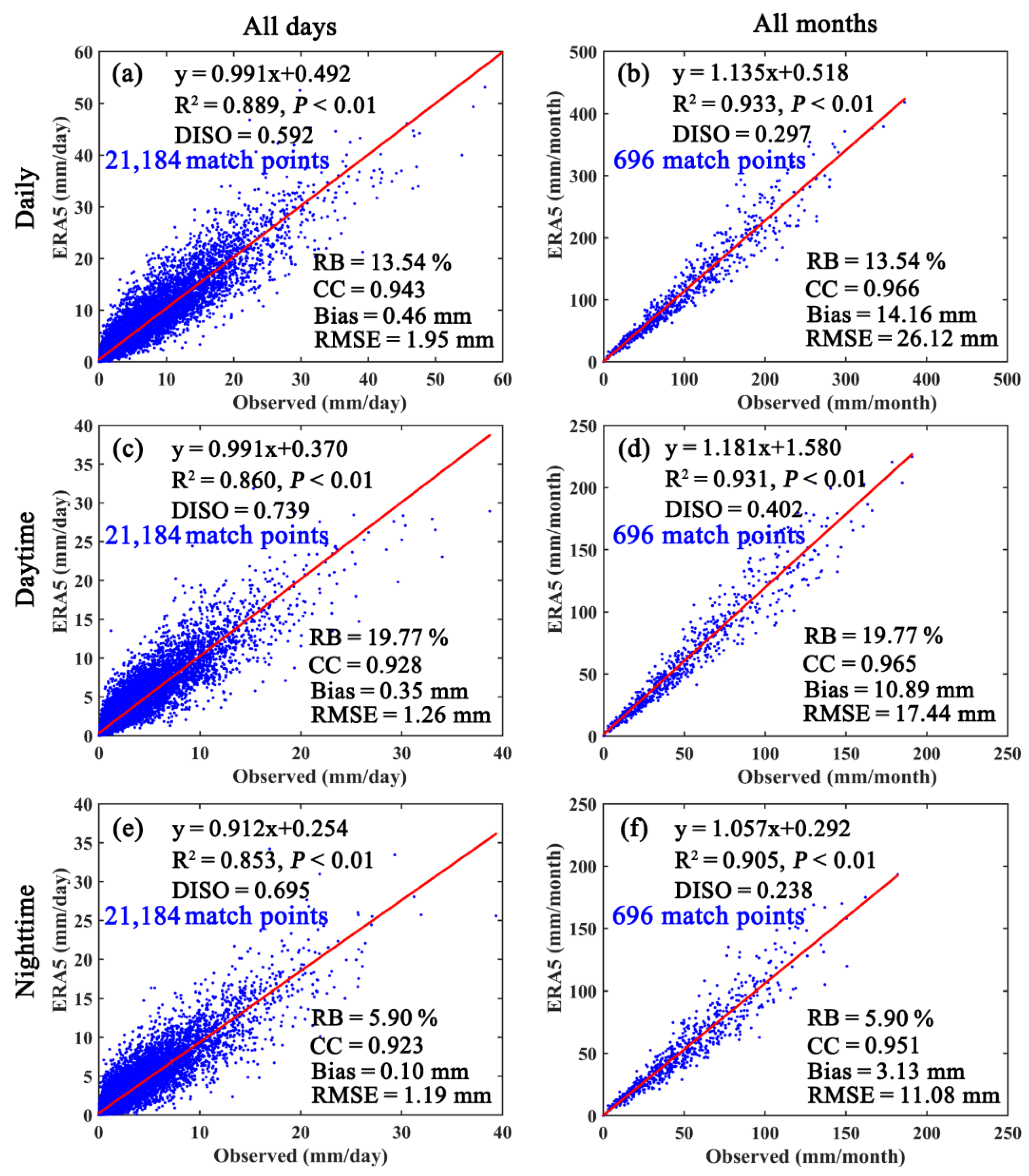
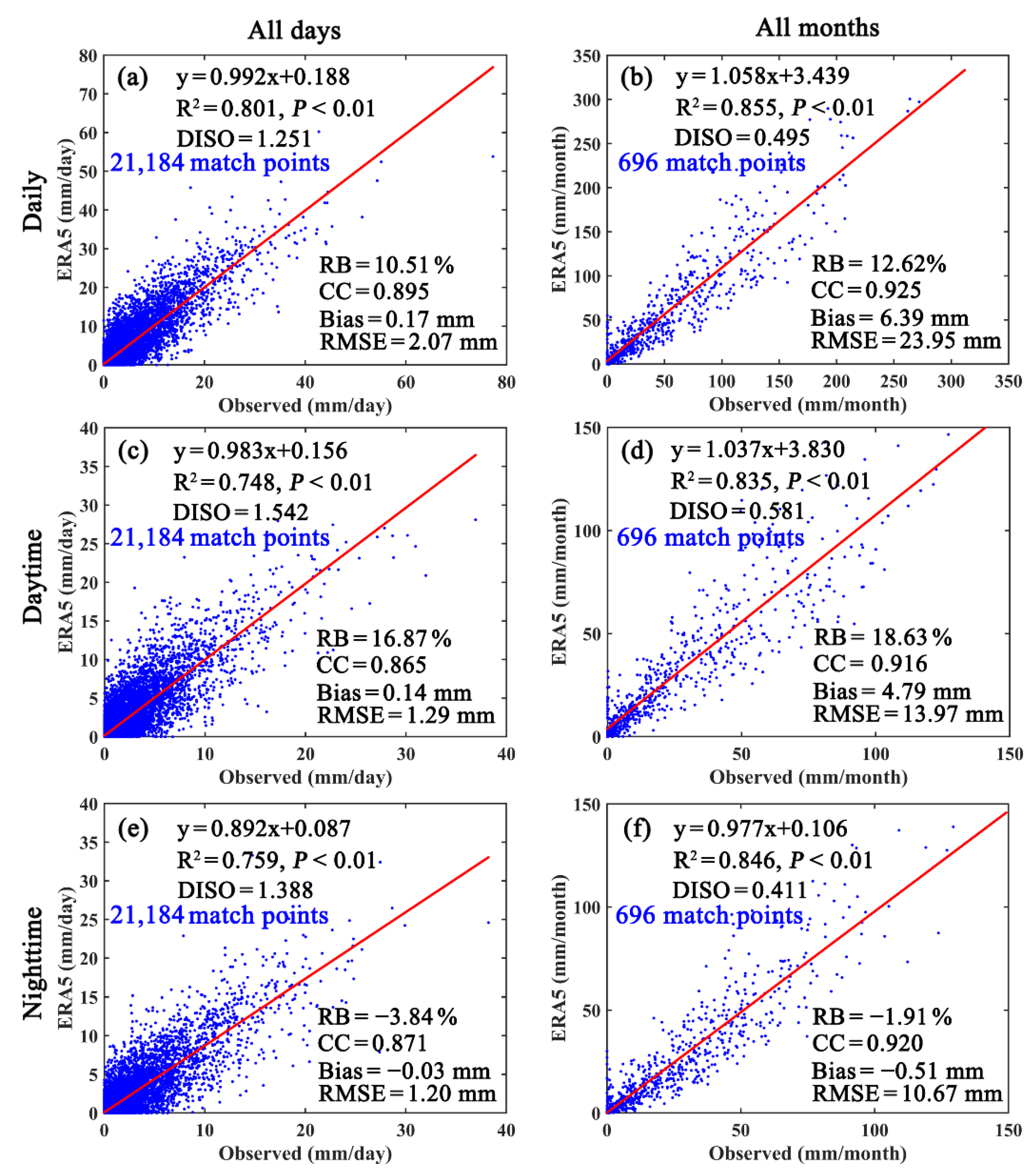
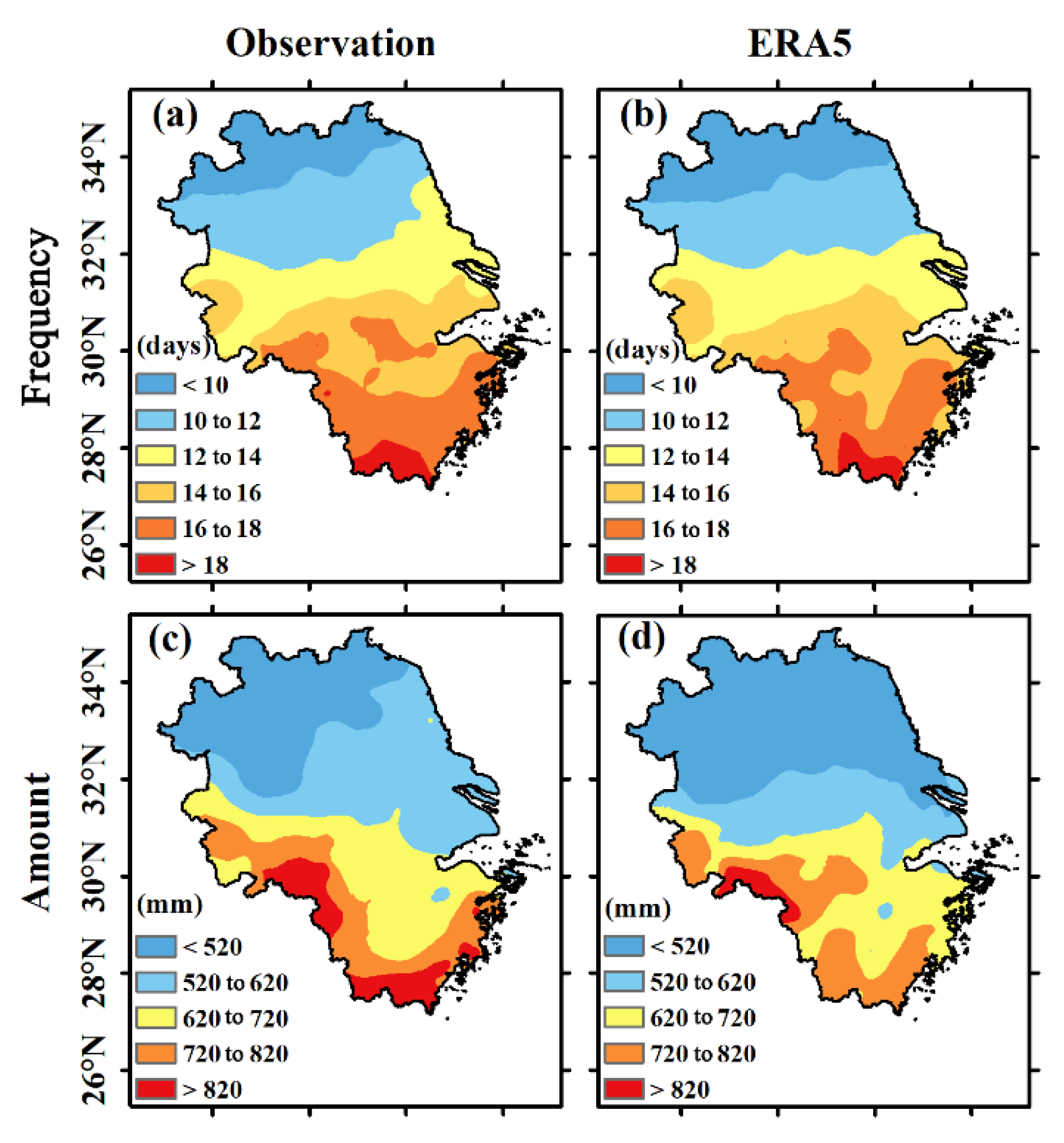
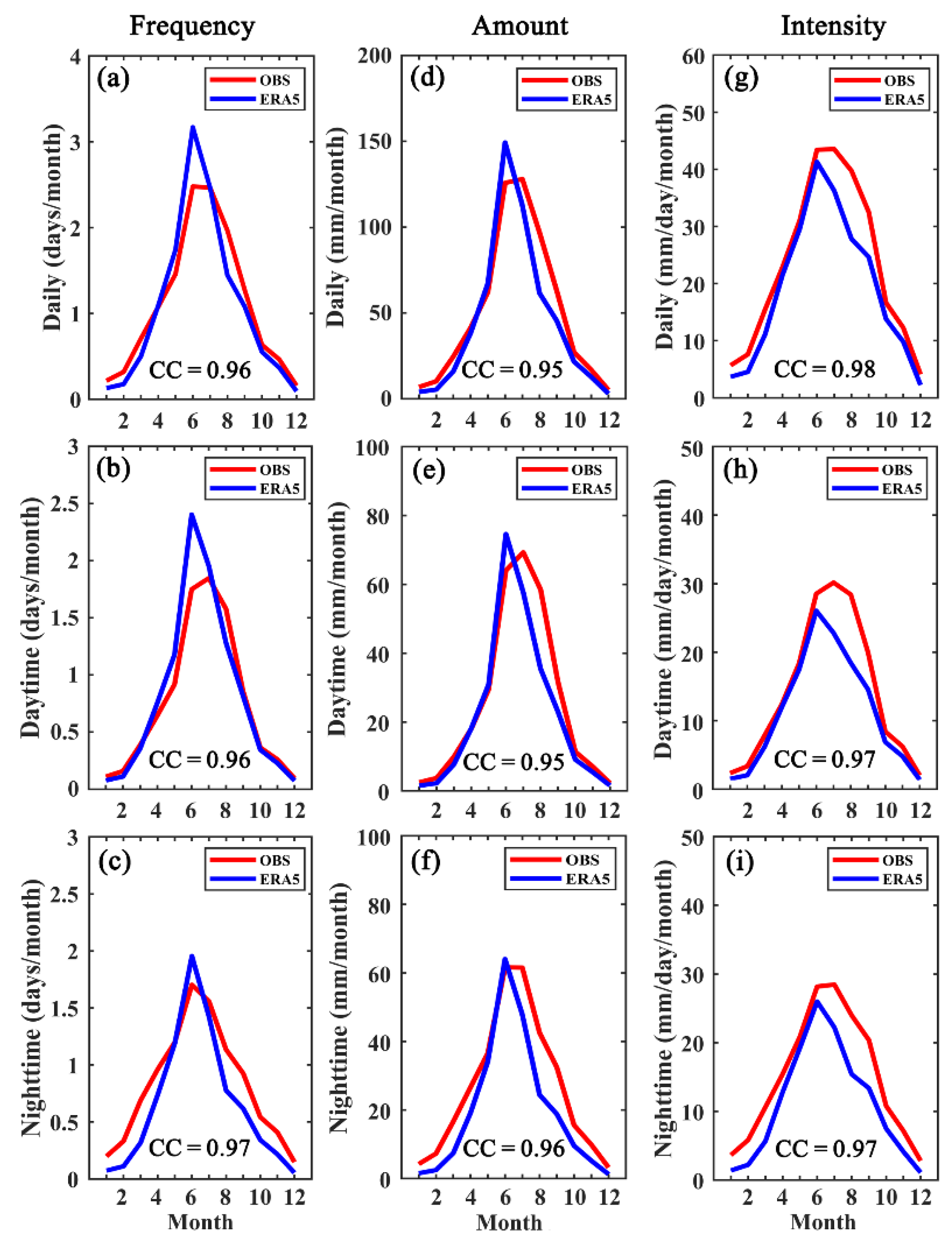

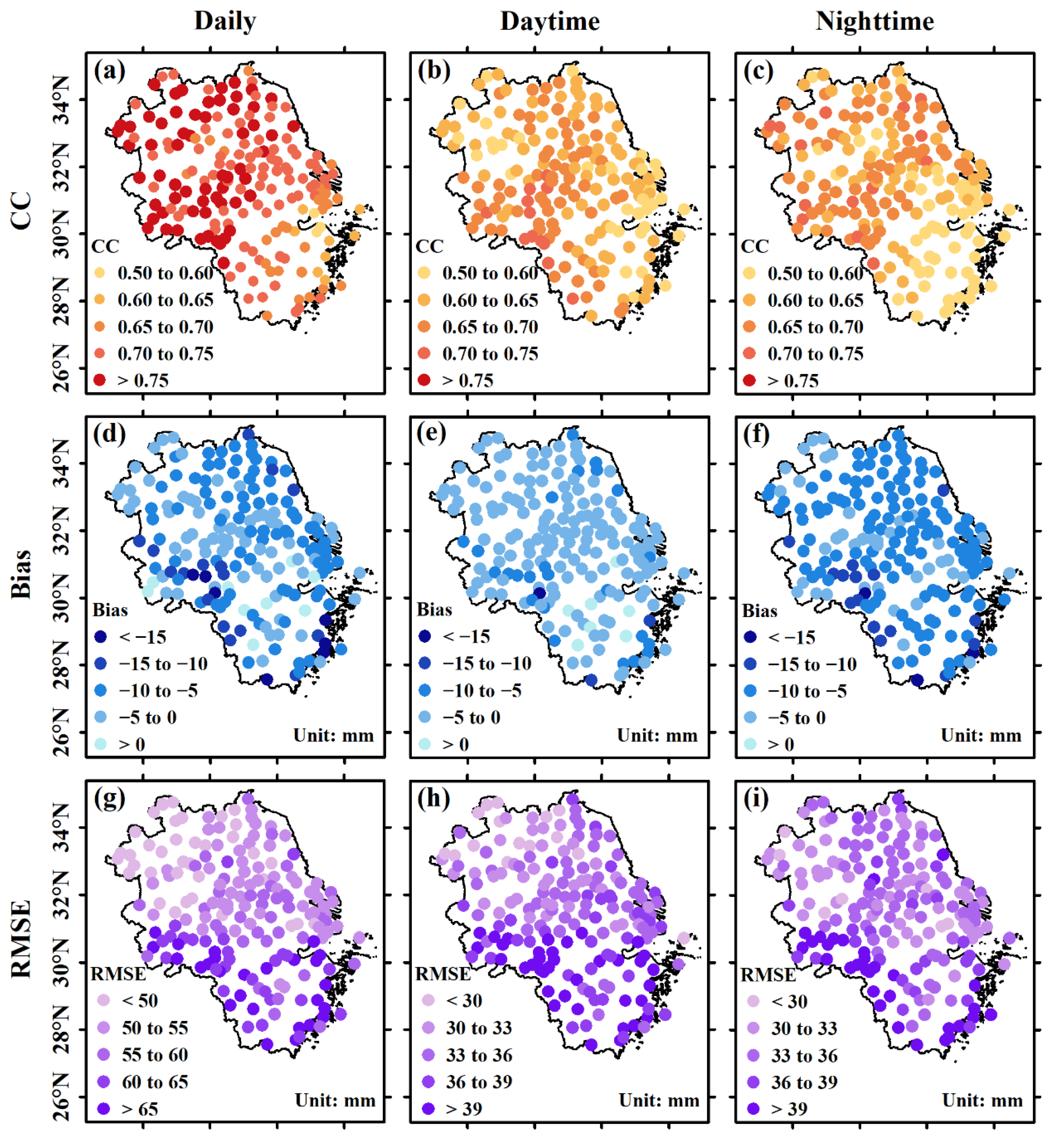
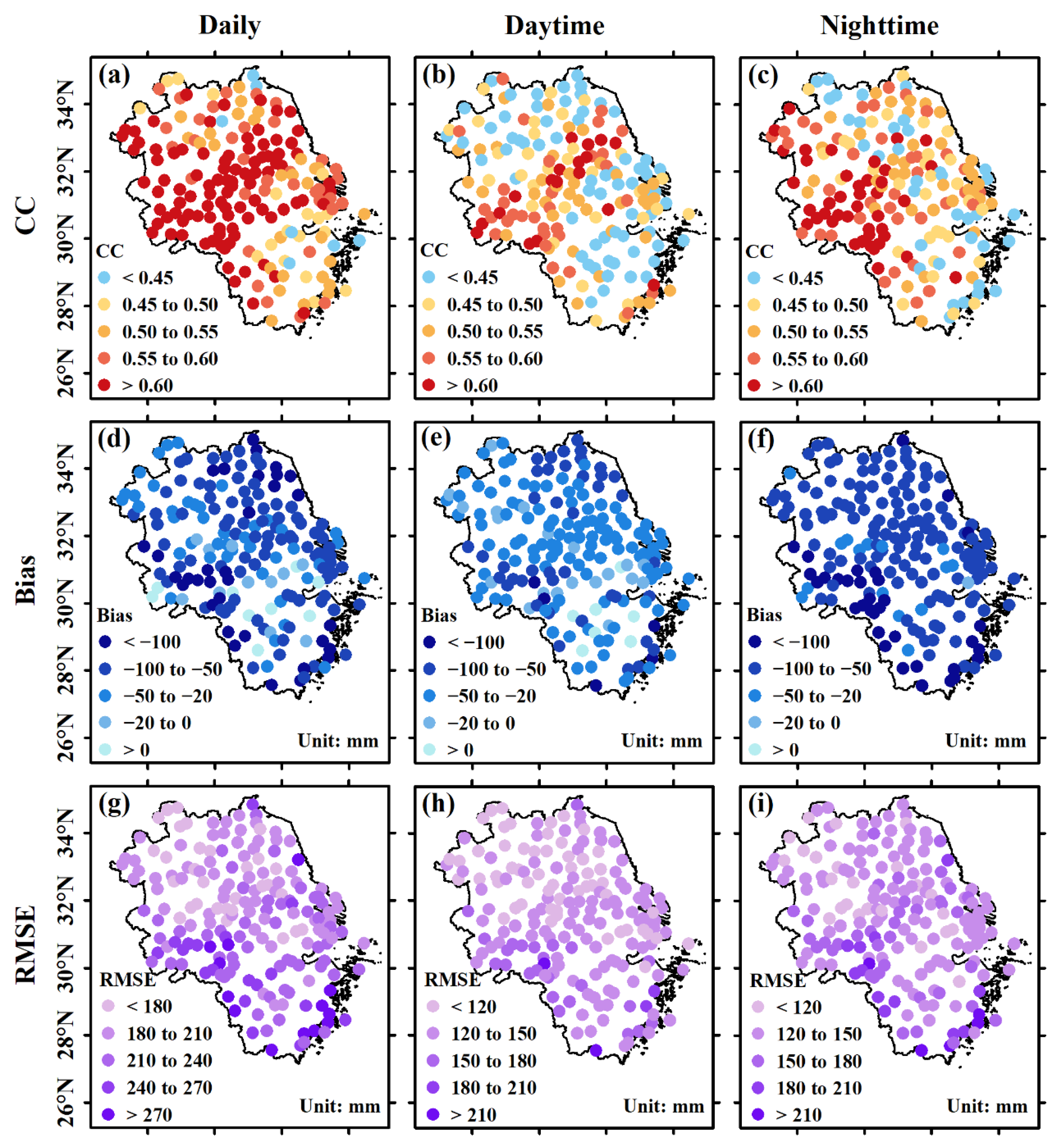
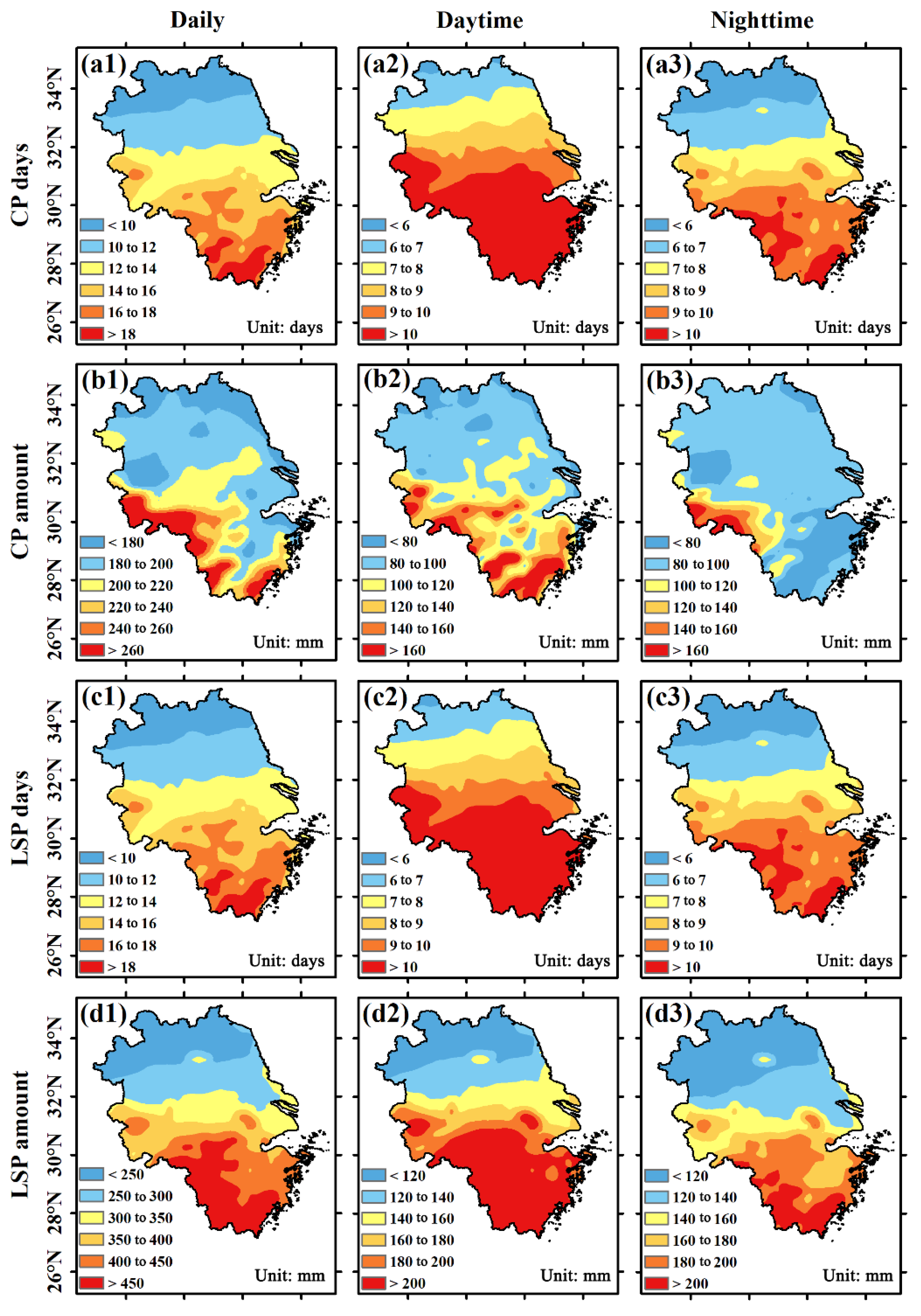
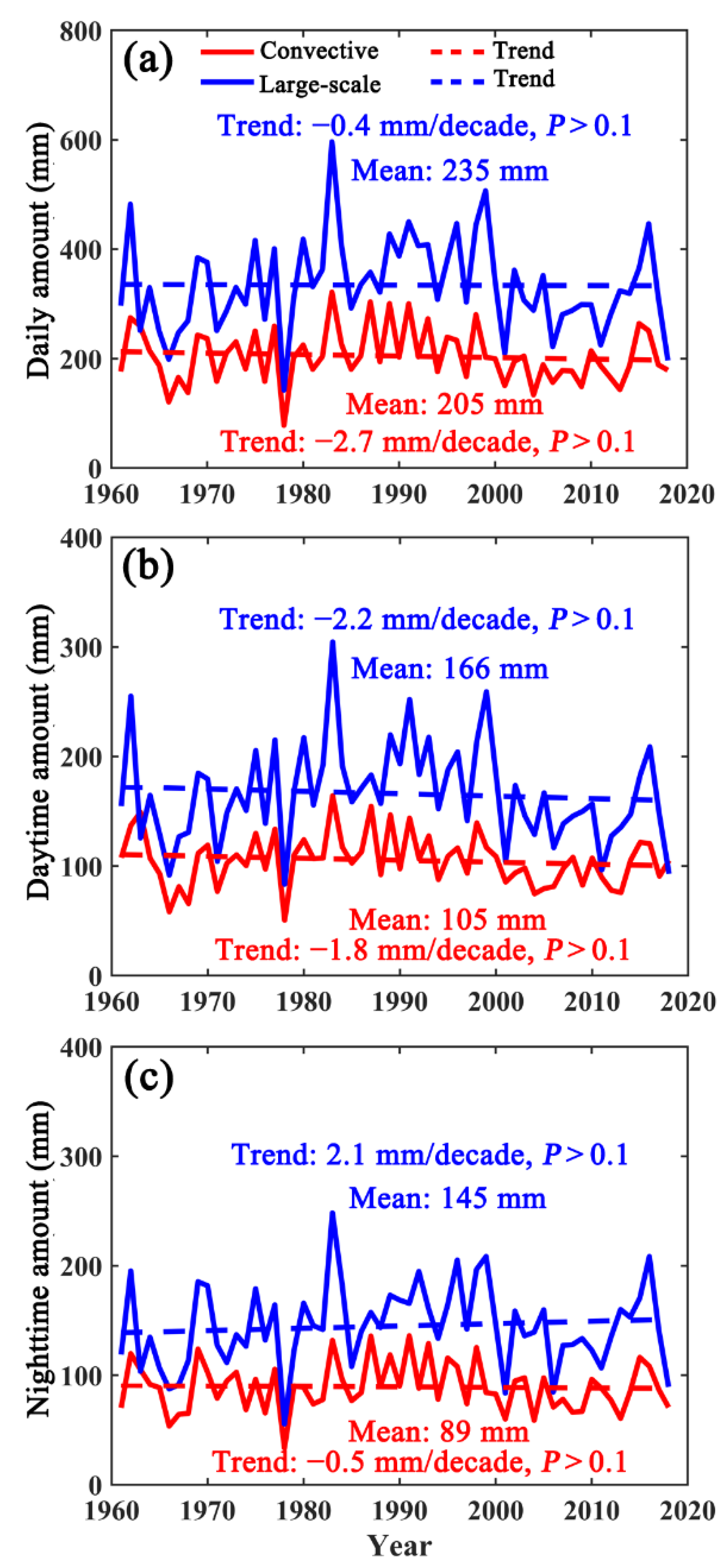
| Threshold | Time Scale | ||
|---|---|---|---|
| Daily | Daytime | Nighttime | |
| Threshold for observation | 24.37 mm | 18.17 mm | 16.17 mm |
| Adjusted threshold for ERA5 | 24.75 mm | 16.95 mm | 17.97 mm |
| Unadjusted threshold for ERA5 | 19.33 mm | 12.56 mm | 13.57 mm |
| Time Scale | Period | Frequency (Days/Decade) | Amount (mm/Decade) | Intensity mm/Day/Decade | |||
|---|---|---|---|---|---|---|---|
| OBS | ERA5 | OBS | ERA5 | OBS | ERA5 | ||
| Daily | 1961–2018 | 0.41 ** | −0.09 | 24.69 *** | −2.14 | 0.49 *** | 0.16 |
| 1961–2000 | 0.49 * | 0.92 ** | 27.76* | 43.64 ** | 0.46 | 0.40 | |
| 2001–2018 | 2.34 ** | 0.85 | 127.37 *** | 49.20 | 1.31 | 1.20 | |
| Daytime | 1961–2018 | 0.30 ** | −0.12 | 12.82 *** | −3.49 | 0.29 *** | −0.01 |
| 1961–2000 | 0.40 * | 0.71 ** | 14.40 * | 21.86 ** | 0.11 | 0.20 | |
| 2001–2018 | 1.65 ** | 0.51 | 70.71 *** | 18.45 | 1.40 ** | 0.52 | |
| Nighttime | 1961–2018 | 0.28 ** | 0.04 | 10.98 ** | 2.02 | 0.24 * | 0.14 |
| 1961–2000 | 0.29 | 0.57 ** | 11.16 | 19.13 ** | 0.24 | 0.28 | |
| 2001–2018 | 1.75 ** | 0.84 | 55.61 ** | 25.82 | −0.12 | 0.14 | |
Publisher’s Note: MDPI stays neutral with regard to jurisdictional claims in published maps and institutional affiliations. |
© 2022 by the authors. Licensee MDPI, Basel, Switzerland. This article is an open access article distributed under the terms and conditions of the Creative Commons Attribution (CC BY) license (https://creativecommons.org/licenses/by/4.0/).
Share and Cite
Shen, L.; Wen, J.; Zhang, Y.; Ullah, S.; Meng, X.; Chen, G. Performance Evaluation of ERA5 Extreme Precipitation in the Yangtze River Delta, China. Atmosphere 2022, 13, 1416. https://doi.org/10.3390/atmos13091416
Shen L, Wen J, Zhang Y, Ullah S, Meng X, Chen G. Performance Evaluation of ERA5 Extreme Precipitation in the Yangtze River Delta, China. Atmosphere. 2022; 13(9):1416. https://doi.org/10.3390/atmos13091416
Chicago/Turabian StyleShen, Liucheng, Jiahong Wen, Yuqing Zhang, Safi Ullah, Xiangchun Meng, and Guanjie Chen. 2022. "Performance Evaluation of ERA5 Extreme Precipitation in the Yangtze River Delta, China" Atmosphere 13, no. 9: 1416. https://doi.org/10.3390/atmos13091416
APA StyleShen, L., Wen, J., Zhang, Y., Ullah, S., Meng, X., & Chen, G. (2022). Performance Evaluation of ERA5 Extreme Precipitation in the Yangtze River Delta, China. Atmosphere, 13(9), 1416. https://doi.org/10.3390/atmos13091416








